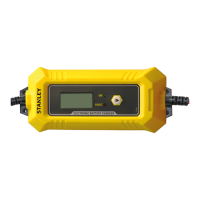6
2.5.
Interruption of the charge cycle
In case of blackouts in the 230V mains, the battery charger saves the work cycle it was performing in
order to restore it automatically as soon as the power supply of the 230V mains is restored. This
function is crucially important if the battery charger is used to charge batteries without the operator
supervising the cycle; for example, during very long work cycles (maintenance charges) or when
charging overnight (charges for vehicles that need to be charged daily). The set parameters are stored
for 12 hours; after 12 hours the battery charger will resume charging with the default parameters.
2.6. Safety devices
The battery charger is equipped with safety devices to ensure the utmost safety during use and
operation.
Full protection against sparks
Protection against short-circuits
Voltage compensation
Protection against overheating
Protection against polarity reversal
High protection rating against external agents, IP65
2.7. Battery tests and error indications
The battery charger is designed to determine the battery’s condition before and while charging, and
inform about any connection faults between the battery charger and the battery to charge. An error
code can be viewed on the digital display, which allows the fault to be quickly and simply checked
out.
The clamps/rings of the output
lead are not connected correctly
to the battery.
Position the clamps/rings correctly
and start charging the battery
again.
Battery voltage too high.
You are attempting to charge a
24V battery with the charger
settled at 12V or y
attempting
battery with the charger settled at
Check the battery voltage.
The battery may be defective.
Contact your battery service
center.
Battery cannot maintain a good
level of charge.
The battery may be defective.
Contact your
center.
Battery unrecoverable after a
complete desulfurization cycle.
The battery may be defective.
Contact your battery service
center.

